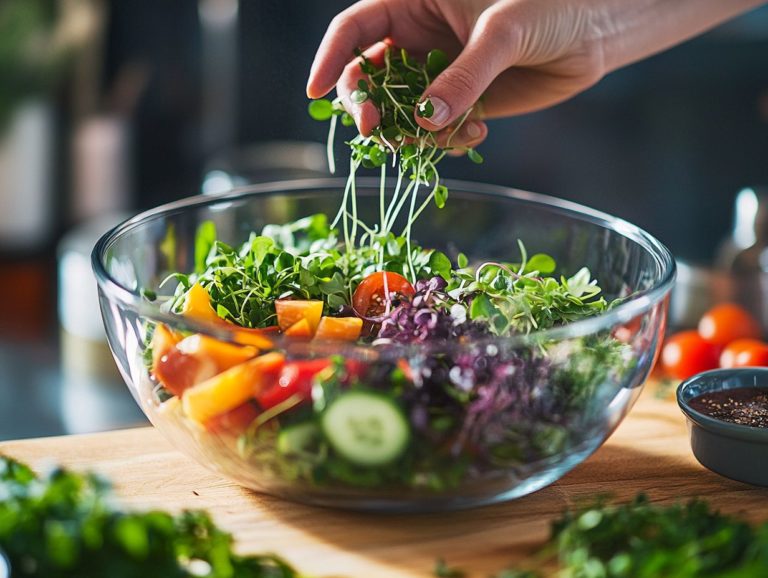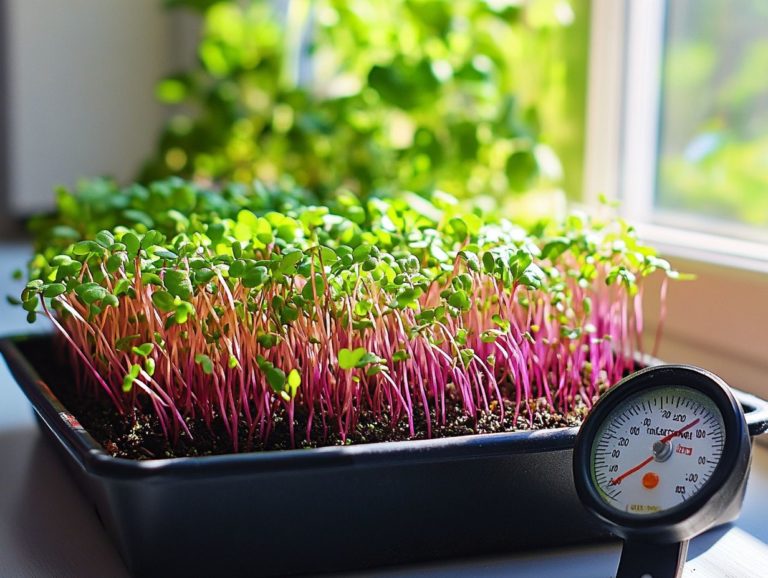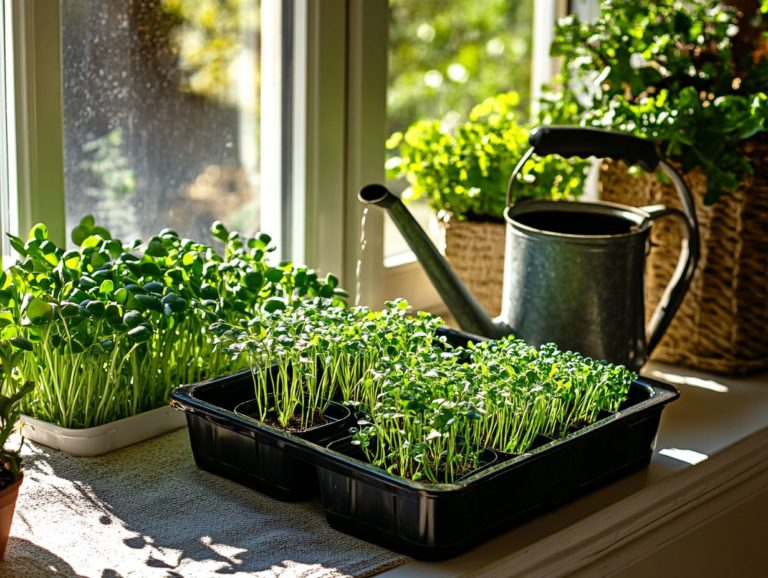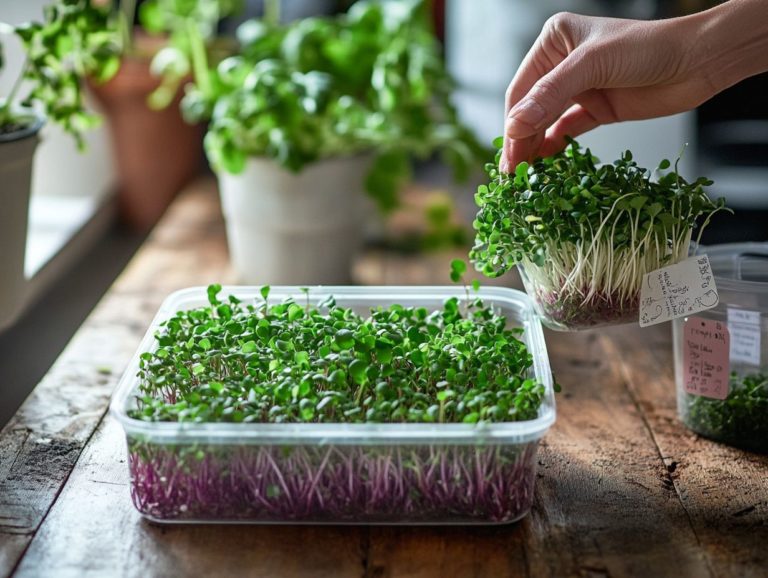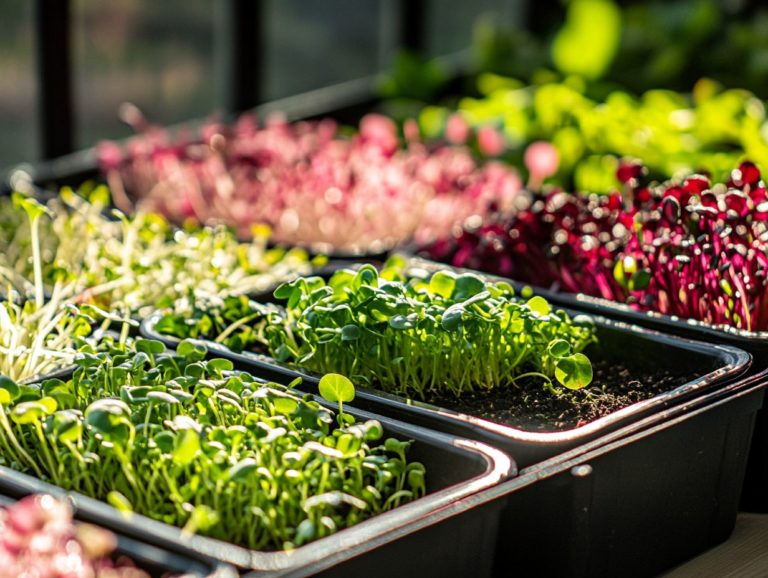How to Grow Microgreens in a Small Space?
Microgreens, those petite powerhouses of flavor and nutrition, are quickly becoming a favorite among home gardeners and culinary aficionados.
This guide delves into everything you need to know about cultivating these vibrant greens in both small indoor and outdoor spaces. You ll explore their myriad benefits, learn how to choose the perfect location, and discover essential supplies along with comprehensive, step-by-step growing techniques.
You ll also uncover valuable tips for harvesting, troubleshooting common challenges, and maximizing your space in creative ways. Prepare to elevate your gardening experience to new heights!
Contents
Key Takeaways:
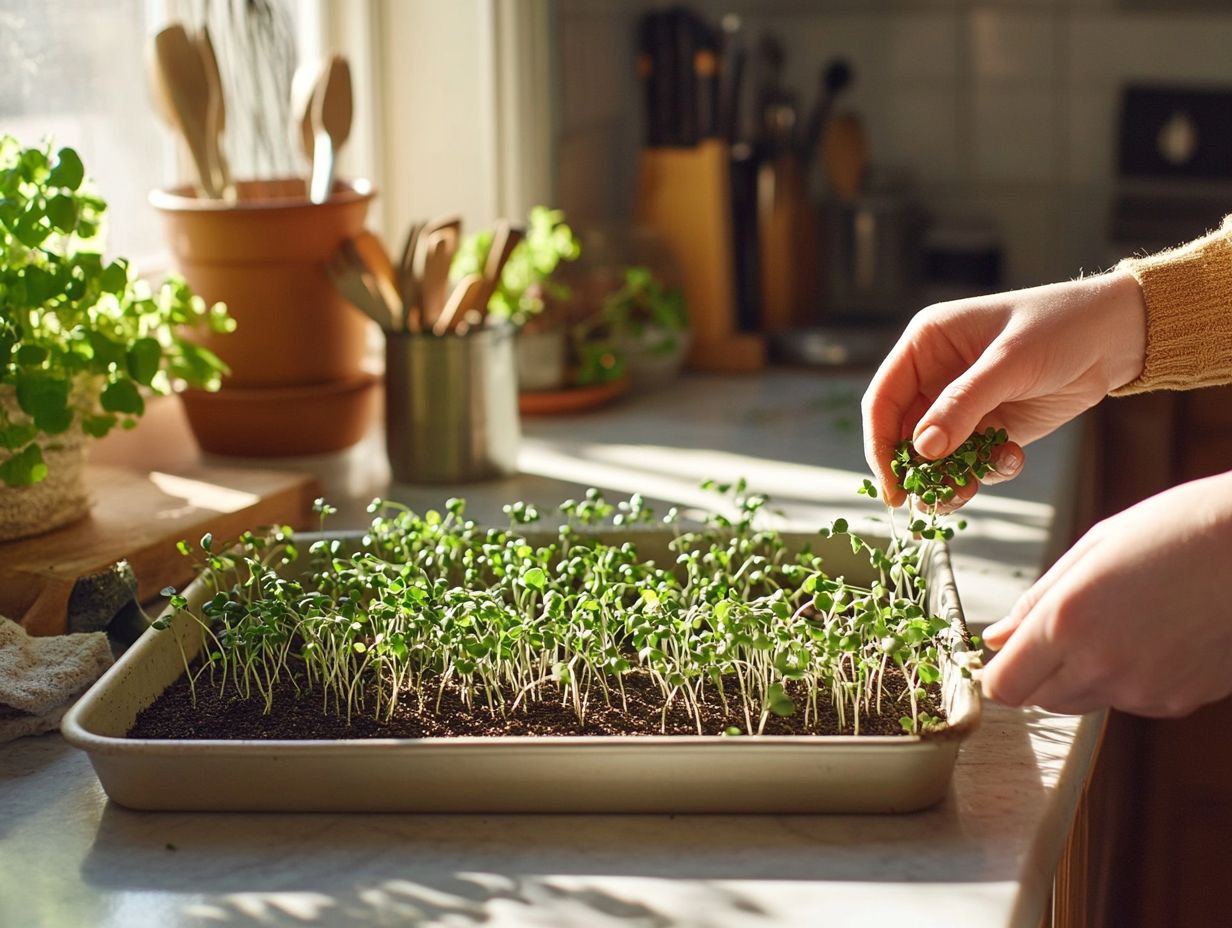
- Microgreens are young, nutrient-dense plants that can be easily grown in small spaces for various health benefits.
- Choose a suitable location for growing microgreens, considering factors such as lighting and space constraints.
- With the right supplies and techniques, anyone can successfully grow microgreens in a small space, from preparation and planting to harvesting and using them in delicious recipes.
Understanding Microgreens: A Quick Overview
Microgreens are young vegetable plants, typically harvested just after their first true leaves have unfurled, presenting a delightful spectrum of colors, flavors, and health benefits. These petite greens have become increasingly popular in sustainable gardening, as they can effortlessly thrive indoors or in limited spaces, elevating your daily meals think salads, Buddha Bowls, and sandwiches into something extraordinary.
Rich in vitamins and antioxidants, microgreens like broccoli sprouts are not only simple to grow but also deliver a formidable nutritional boost, making them a critical component of any home gardening endeavor.
Definition and Benefits
Microgreens are the young seedlings of edible vegetables, herbs, and other plants, harvested at an early growth stage typically within 7 to 21 days after germination.
These tiny greens pack an incredible nutritional punch that will amaze you! They often contain higher concentrations of vitamins, minerals, and antioxidants compared to their mature counterparts. For example, certain varieties of microgreens can boast up to five times more vitamin C and E than fully grown vegetables.
But it s not just their remarkable nutritional value that makes them stand out; these vibrant greens also enhance the flavor of various dishes. They add a fresh, peppery, or slightly sweet note that can elevate everything from salads to sandwiches. Their versatility makes them an ideal addition to health-promoting diets, encouraging you to effortlessly incorporate more plant-based nutrition into your meals.
Choosing the Right Space for Growing Microgreens
Selecting the ideal space for cultivating microgreens is essential for their success and growth. Whether you decide to embrace indoor gardening in kitchens or on windowsills, or prefer the charm of outdoor growing in garden beds or containers, the environment you choose plays a pivotal role.
Microgreens thrive on plenty of natural sunlight and a proper growing medium. It’s crucial to assess the light availability and overall conditions of your chosen location. For those interested in maximizing their microgreen yield, learning how to use hydroponics for microgreens can be especially important in small spaces or urban settings, where sunlight might be a precious commodity.
Indoor vs Outdoor Growing
When you’re weighing the choice between indoor and outdoor growing for your microgreens, it s crucial to consider factors such as your available space, the amount of natural sunlight you receive, and your gardening expertise.
Each environment brings its own set of advantages and challenges that can profoundly influence the success of your crops. For example, outdoor growing provides generous access to natural light and ample space, making it ideal for larger batches. However, it also subjects your plants to the whims of unpredictable weather conditions.
On the flip side, an indoor setup offers you more controlled conditions, allowing for year-round cultivation. Just keep in mind that you may need to invest in artificial lighting to achieve optimal growth.
To establish a successful indoor microgreens kit, select a shallow container with drainage, fill it with high-quality soil, and choose a spot that enjoys plenty of sunlight, preferably a south-facing window. If you find that natural sunlight is lacking, don’t hesitate to bring in grow lights to supplement and ensure your microgreens not only survive but truly thrive. For detailed instructions, refer to this step-by-step guide to sowing microgreens.
Don’t wait any longer—start growing your own microgreens today and transform your meals into something extraordinary!
Supplies and Equipment Needed
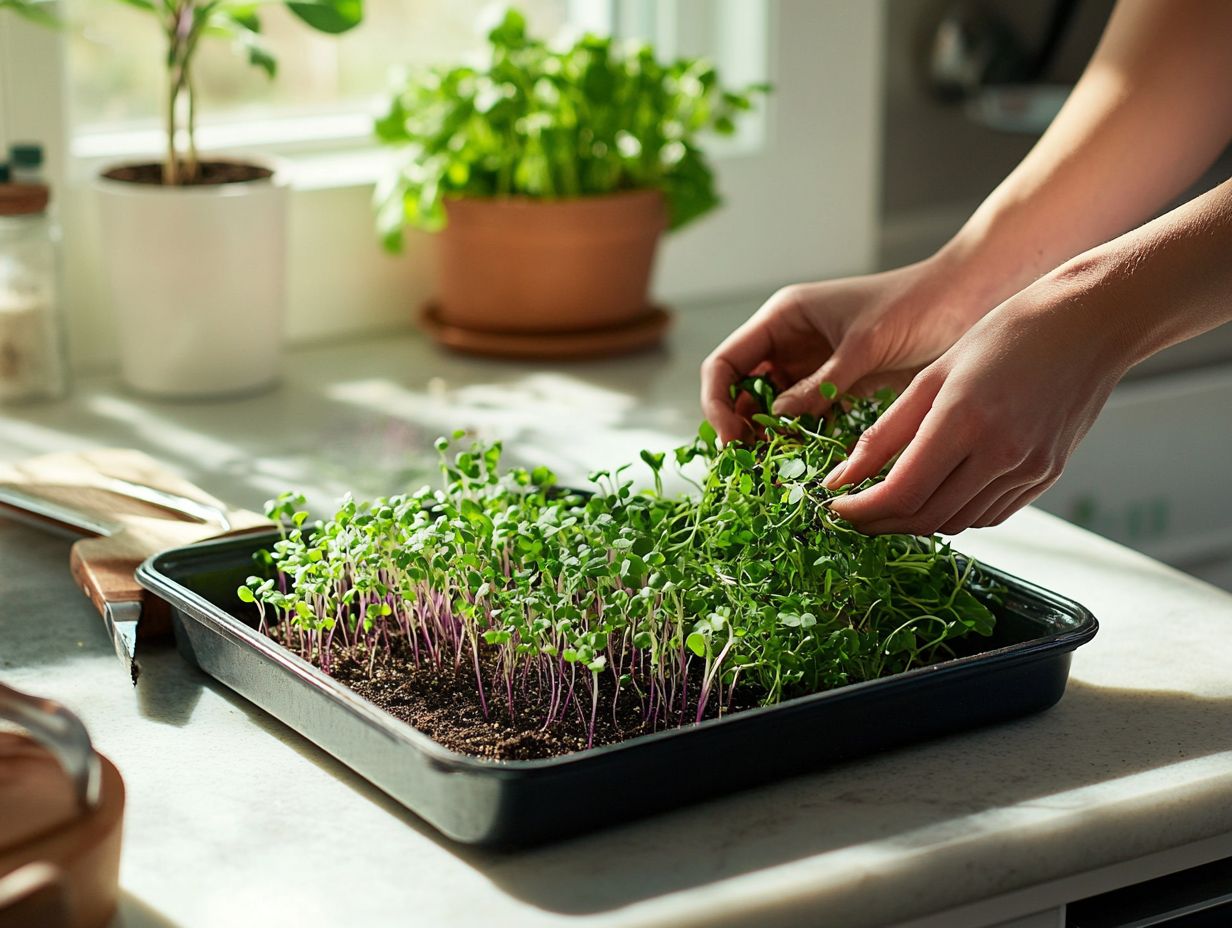
To successfully cultivate microgreens at home, you’ll need an array of supplies and equipment. A well-equipped microgreens kit is essential, as it typically includes trays, growing mediums, and a selection of microgreen seeds designed for the best growth.
Essential Tools and Materials
The essential tools and materials for growing microgreens are vital to your success. They include planting trays, a suitable growing medium, and high-quality microgreen seeds. Each component plays a crucial role in nurturing flavorful and nutritious plants.
The choice of trays significantly influences drainage and airflow, both critical for healthy growth. For those interested in optimizing their setup, learning how to use a grow tent for microgreens can be beneficial. For growing mediums, you can use options like soil, coconut coir, or hydroponic mats; each offers different levels of nutrients and moisture retention, affecting how quickly and robustly your microgreens thrive.
Selecting top-notch seeds is equally important; make sure to choose fresh seeds suited to your climate and growing conditions. This ensures the best results for germination and growth. By paying attention to these details, you’ll set the stage for a bountiful and vibrant microgreen harvest.
Steps to Growing Microgreens
Growing microgreens is a rewarding endeavor that follows a clear process. Here are the essential steps:
- Preparation
- Planting
- Maintenance
By providing your sprouting seeds with the optimal conditions, you pave the way for robust growth and thriving development.
Preparation, Planting, and Maintenance
Preparation, planting, and maintenance are crucial stages in growing microgreens. Understanding each step will help you optimize the growing process.
In the preparation stage, select high-quality microgreen seeds tailored to your intended use whether for culinary creativity or nutritional benefits. Choose the right growing medium like seed-starting mix, potting soil, or coconut coir to create the perfect environment for germination, which is when seeds start to sprout. Additionally, learn how to maximize yields from microgreens to enhance your growing experience.
During the planting stage, it’s vital to maintain the right soil moisture; seeds thrive in moist but not soggy conditions. After planting, ongoing maintenance involves placing your trays in an area with ample natural sunlight. For best results, consider using techniques for growing microgreens year-round. Regularly check and adjust moisture levels to foster healthy growth. Watch moisture and light levels closely to grow vibrant, tasty microgreens.
Harvesting and Using Microgreens
Ready to enjoy the delicious flavors of your homegrown microgreens? Timing is everything! Harvesting microgreens at the perfect moment is essential for unlocking their full flavor and health benefits. By following best practices, you can ensure that you optimize your crop, whether incorporating them into salads, wraps, or using them as elegant garnishes for various dishes.
Best Practices and Recipes
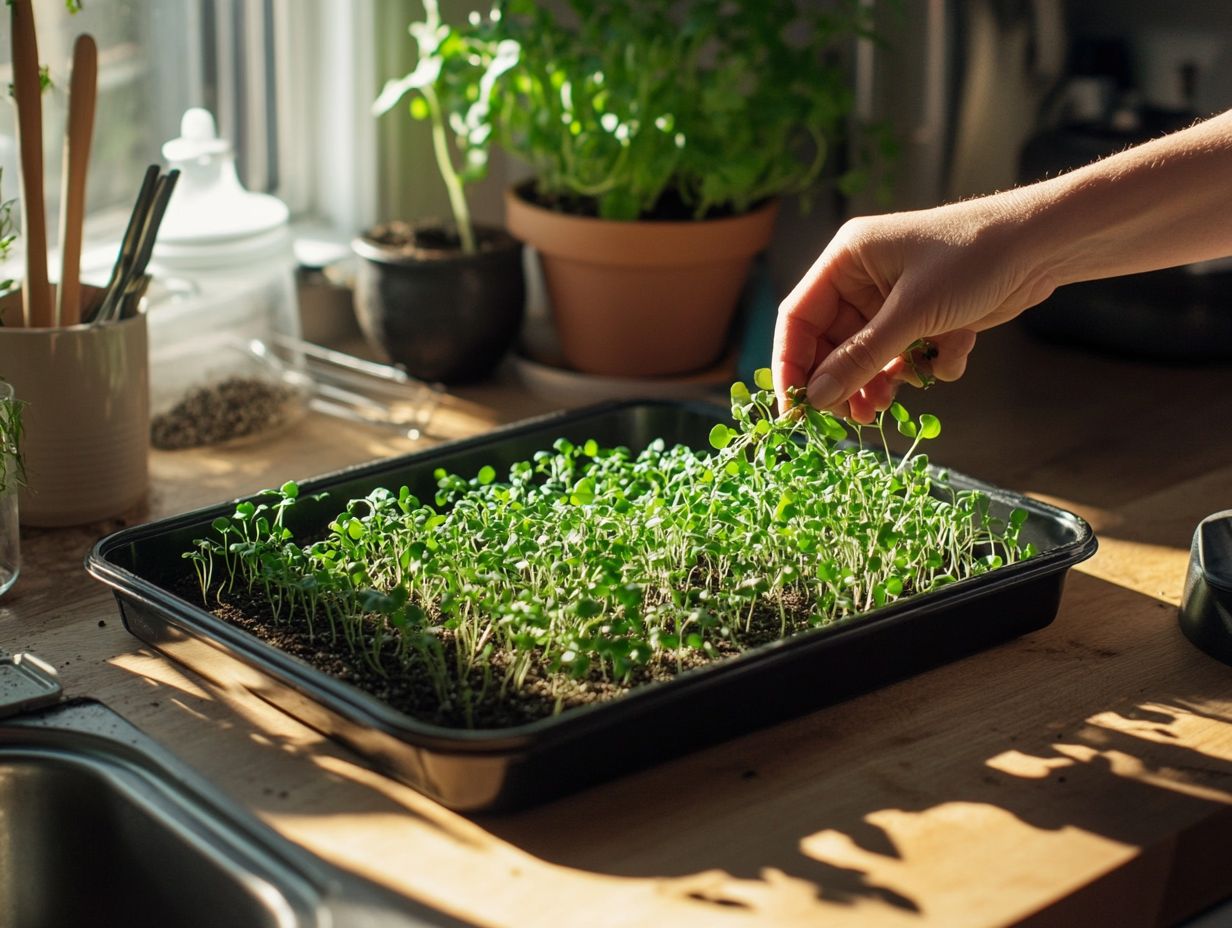
Adopting best practices when harvesting microgreens can enhance their flavor and health benefits. This allows you to craft exquisite recipes that showcase their unique tastes and nutritional value.
As you approach the final steps of cultivation, it s crucial to harvest the microgreens just before they develop true leaves. This timing maximizes their delightful crunch and vibrant flavors.
Pair this with proper storage methods, such as placing them in a breathable container in the refrigerator, to maintain their freshness. These practices will help ensure that vibrant colors and bold flavors remain intact.
Incorporating microgreens into your dishes like fresh salads, gourmet sandwiches, or as a garnish on soups can elevate your meals. Their peppery, sweet, or earthy notes will add layers of complexity that truly tantalize the palate. For those interested in growing their own, check out these tips for growing microgreens in winter.
Troubleshooting Common Issues
Troubleshooting common issues while cultivating microgreens is crucial for your success. Factors like pests, diseases, and improper soil moisture can dramatically hinder both growth and yield.
By addressing these challenges proactively, you can ensure a thriving microgreens garden that meets your expectations.
How to Address Pests and Diseases
Addressing pests and diseases is essential for maintaining the health of your microgreens. These challenges can disrupt growth and diminish the myriad benefits they offer.
Spot problems early, and you’ll be on your way to a thriving microgreens garden! Regularly inspect your microgreens for visible signs of pests like tiny holes in leaves or discolored spots.
Adjusting your watering routine is key. Keep the soil moisture levels optimal neither too dry nor too wet to reduce the risk of root rot and other diseases.
Ensure good air circulation and cleanliness in your growing area to prevent pathogen buildup. Introducing good bugs that help keep harmful pests away offers a natural method of pest control.
Remember, prevention is always better than cure. Early detection and careful nurturing are critical for thriving microgreens, and understanding the benefits of growing microgreens vertically can enhance your gardening success.
Tips for Maximizing Small Space
Maximizing small spaces for growing microgreens is entirely within your reach through innovative strategies like vertical gardening. This approach enables you to fully utilize every square foot of your home gardening setup, transforming even the coziest of corners into a flourishing green oasis.
Vertical Gardening and Creative Solutions
Vertical gardening and creative solutions are your secret weapons for maximizing limited space in indoor gardening. This method allows you to grow microgreens efficiently while adding a touch of visual flair to your home.
By utilizing walls, shelves, and tiered plant stands, you can transform your small apartment or compact living area into a vibrant green sanctuary. Wall-mounted planters provide an innovative way to cultivate herbs and flowers at eye level, seamlessly integrating into your existing decor. To enhance your indoor gardening experience, consider learning how to use grow lights for microgreens for optimal growth.
Consider vertical racks or hanging systems to free up precious floor space, enhancing mobility and simplifying maintenance. With the right structure and a sprinkle of creativity, you can craft a lush environment that not only boosts productivity but also invites relaxation and beauty, making indoor gardening a delightful blend of function and aesthetics. For those interested in growing microgreens, using sprouting trays can be an effective technique to explore.
Frequently Asked Questions
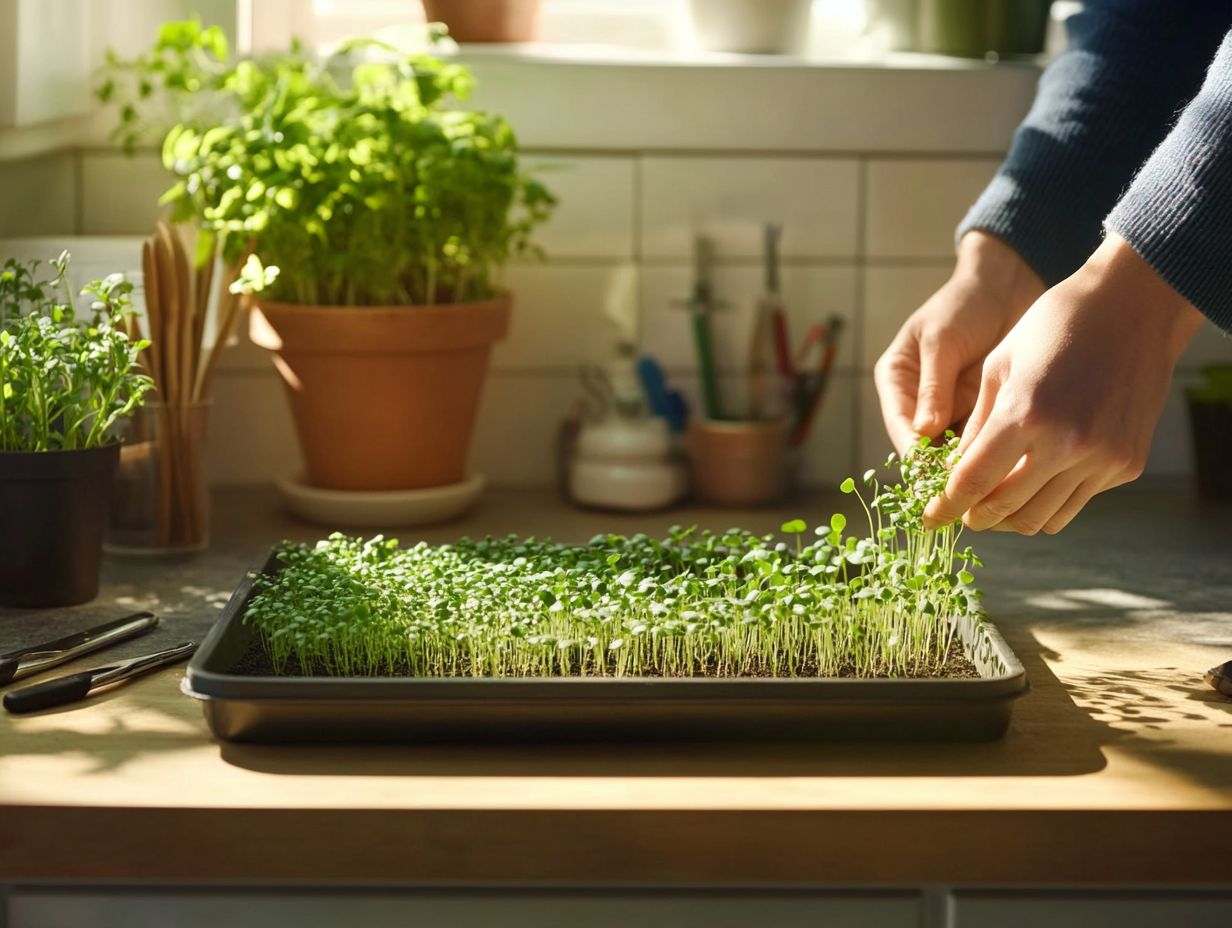
What are microgreens?
Microgreens are young, tender greens harvested when they are only a few inches tall. They are packed with nutrients and add a burst of flavor to salads, sandwiches, and other dishes.
How can I grow microgreens in a small space?
Microgreens can easily be grown in a small space, such as a windowsill, balcony, or countertop. They require minimal equipment and can be grown in containers or trays.
What are the best microgreens to grow in a small space?
Some of the best microgreens to grow in a small space include broccoli, radish, sunflower, kale, and pea shoots. These varieties are compact and grow quickly, making them perfect for small spaces.
How do I prepare my small space for growing microgreens?
To prepare your small space for growing microgreens, ensure it receives at least 4 hours of sunlight per day and has good air circulation. You can also use artificial grow lights if necessary.
How often do I need to water my microgreens?
Microgreens require regular watering to keep the soil moist but not waterlogged. It is recommended to water them once or twice a day, depending on the temperature and humidity levels in your space.
How long does it take for microgreens to grow in a small space?
Most microgreens will be ready for harvest in 1-2 weeks, depending on the variety. However, some may take up to 3 weeks. Monitor their growth and harvest them when they reach the desired height and have developed their first set of true leaves.
Start your microgreens adventure today and enjoy fresh greens in just weeks!

